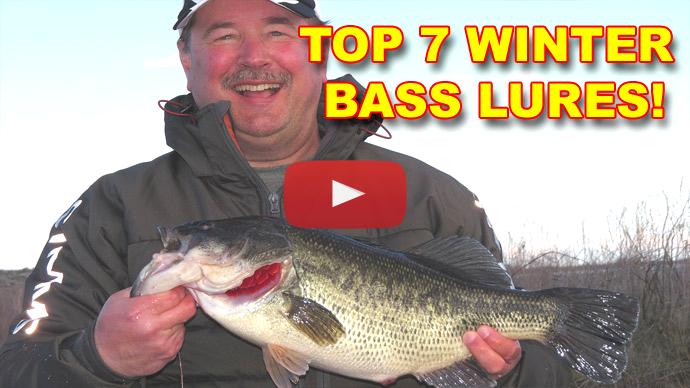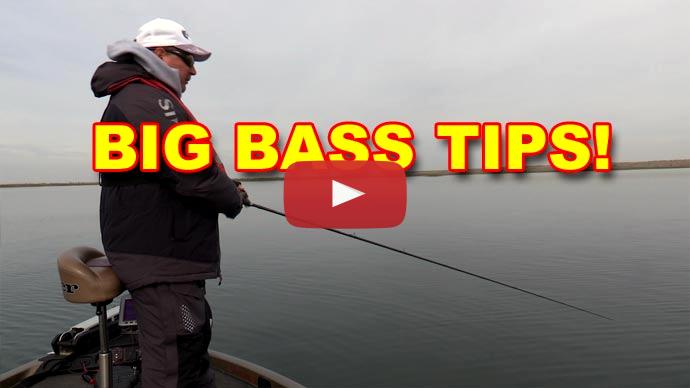Glenn: That was a pickup. It just got light. I just lost the weight. There we go. Coldwater jig fish. All right. Not a huge one. But hey, I'll take it in the wintertime.
Hey, folks. Glenn May here with BassResource.com. And today, I want to talk to you about a misconception about bass during the wintertime that keeps getting spread around. And I admit, I used to think the same thing too and I've probably said it a few times too in the past. And I had a viewer correct me on this. And I looked into it and sure enough yep, he was right.
So let me explain. It's the notion that bass are slow and lethargic during the wintertime. Now that gets talked about a lot. And the reality is bass can move about just as quickly during the wintertime as they do in the summertime. The water temperatures don't really affect their mobility. So they can dart in, they can chase down baits. They've got that speed that they've always had. They're not lethargic.
But what the wintertime temperatures do, the colder water temps when they get down below 50 they do two things. They affect the bass metabolism and they affect the forage base they go after. Let's talk a little bit about the metabolism first.
A bass's metabolism is completely dictated by the water temperature. The warmer the water it is the higher the metabolism it is. So what that means is during the summertime when the water temperatures are at their highest a bass will digest food a lot faster than during the wintertime. They'll probably feed several times during the day in the summer. Whereas, in the wintertime, they may only feed once or twice a week because they just don't digest food that fast. That's one thing that the water temperature does.
The other thing is it affects the speed, if you will, of their forage and this is really critical, really critical. Shad, even perch to a certain extent and other forage will slow down when the water temperature gets down in the 40s and even the low 40s. Some shad species, they struggle to stay alive. They're trying to conserve energy. They don't move around much. They're just trying to stay upright, and some of them are dying off.
Crawdads, they will also slow down. Now, crawdads, just as a side note. They don't hibernate. That's another misconception, but crawdads don't hibernate in the wintertime. But they do slow down considerably. Whereas in the summertime when they try to get away from their predators they will kick their tail really fast. And they can move, scoot across the floor of the lake really fast.
But in the wintertime, you hardly ever see them do that. They do slow down quite a bit. They bury up in the mud. They hide in crevices and cracks. And they don't feed very often. Their metabolism is slow as well. But they also because they don't move very fast they want to stay hidden from predators. So, you don't see them that much in the winter. So a lot of people think crawdads hibernate.
Keri: There you go. That's much better.
Glenn: There we go.
Keri: Much better. A little 8 incher.
Glenn: Oh, he's a little bigger than that. I think a little bit bigger than that.
Keri: Maybe 10.
Glenn: Welcome on board, big guy.
Keri: Look at that.
Glenn: He is cold.
Keri: He's cold?
Glenn: Cold. You're cold. Got 'em right in the cheek. That'll work.
At any rate, because these forage are moving around really slow that's what the bass are keying on. That's what they're feeding. And so if you move your lure really fast through the water column. Whether it's dragging on the bottom or with a crankbait, or spinnerbait, or something like that. That looks unnatural to them during this time of year. So, they may shy away from it. They're looking for really slow-moving, easy targets. They've been feeding on that this whole winter. So, you have to match the hatch.
You've gotta move slowly in order to look like what the bass are feeding on.
You know, it's not to say bass won't hit fast-moving lures during the wintertime. They will. I've caught bass on buzz baits. On New Years Day, 42-degree water temperature, and I've caught bass on buzz baits. It was a weird situation. I happen to see some fish busting the surface off a point which is they're not supposed to do that either during the wintertime. But sure enough, that's what they were doing. So, I tied on a buzz bait. Threw out where they were busting fish and caught a few that way. Okay? They will chase down fast-moving baits. That's an anomaly though because their forage is moving slow. So, you need to move slow.
And this is where that misconception comes in. You're moving your baits really slow and methodically with long pauses in between. Plus, the bass's metabolism. They're not eating very much.
So what happens is, whereas in the wintertime, let's just pick 20 bass. You've shown your lure to 20 bass in the summertime. 19 of them might be in a feeding mood. And you'll probably get a few of those to bite your lure. Whereas in the wintertime, that same 20 there might be one or two that are actually thinking about eating. And they might not be liking what you're presenting to them. So, your bites are few and far between as a result.
You're just presenting it to a smaller population that are interested in feeding. And you can't move that fast. You can't cover a whole lot of water because you have to have a slow presentation.
So what happens is to the guy that's holding the rod is, “I’m moving really slow. And I'm not getting many bites the whole day. That must mean the bass are slow and sluggish.”
So don't make that leap. That's not what's happening. Some may think that this is a distinction without a difference. But the reality is if you know what the forage is doing and how the bass are reacting to the forage. That helps you become a better angler.
It gives you the right mindset to give the right presentation. And also sets forward your expectations as to how often you're gonna get bit.
But I tell you what, even though you don't get a lot of bites during the wintertime. The ones you do get are generally a big one.
So, I hope that helps. More tips like this, go on BassResource.com. Check it out.



